Governance Rulesets
Last updated:
Overview | Quick Start | How It Works | Manage Rulesets | Use Cases | Best Practices | FAQs | Troubleshooting
Availability
- Version: Available since v0.2
Overview
Governance Rulesets enable you to define, manage, and enforce API standards across your organization through customizable rules. These rulesets act as executable policies that define your organization’s API governance requirements, helping you establish consistent standards for security, design, and documentation.
Key Benefits
- Standardize API Development: Define consistent patterns and practices for all APIs
- Centralize Governance Policies: Maintain standards in a single location accessible to all teams
- Customize to Your Needs: Create organization-specific rules or use pre-built templates
- Evolve Standards Gradually: Adjust rule severity and scope as your governance program matures
- Share Knowledge: Embed best practices and remediation guidance directly in rules
Dependencies
- Requires Tyk Governance v0.2 or higher
Quick Start
In this tutorial, we’ll create a simple governance ruleset that can be used to validate APIs.
Prerequisites
- Access to Tyk Governance Hub
Step-by-Step
-
Access the Rulesets Section
Navigate to the Rulesets section in your Tyk Governance dashboard.
-
Create a New Ruleset
Click the “Create new ruleset” button to create a new ruleset.
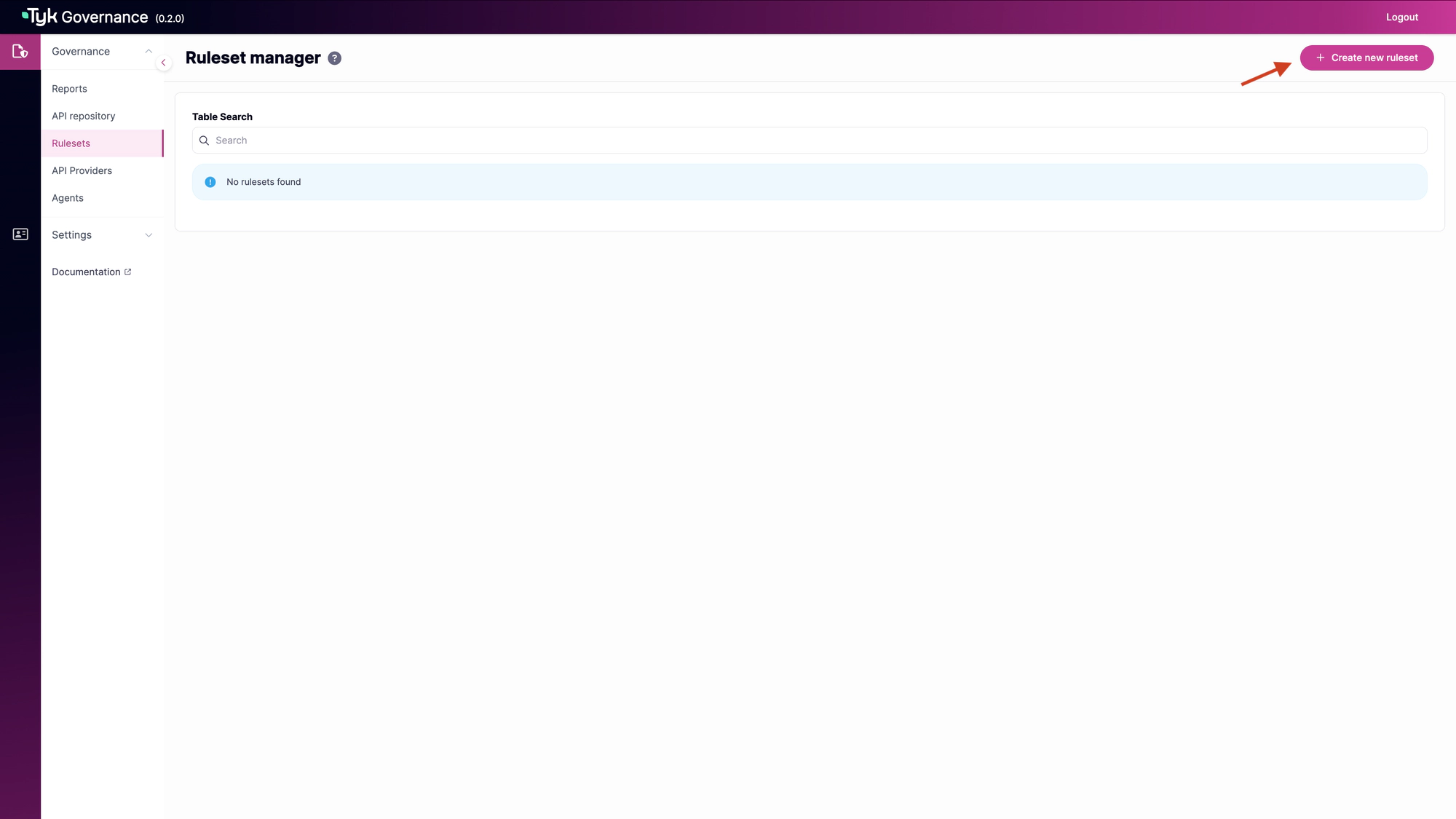
-
Choose a Template
Select “Start from Template” and choose the “vacuum-owasp” template.
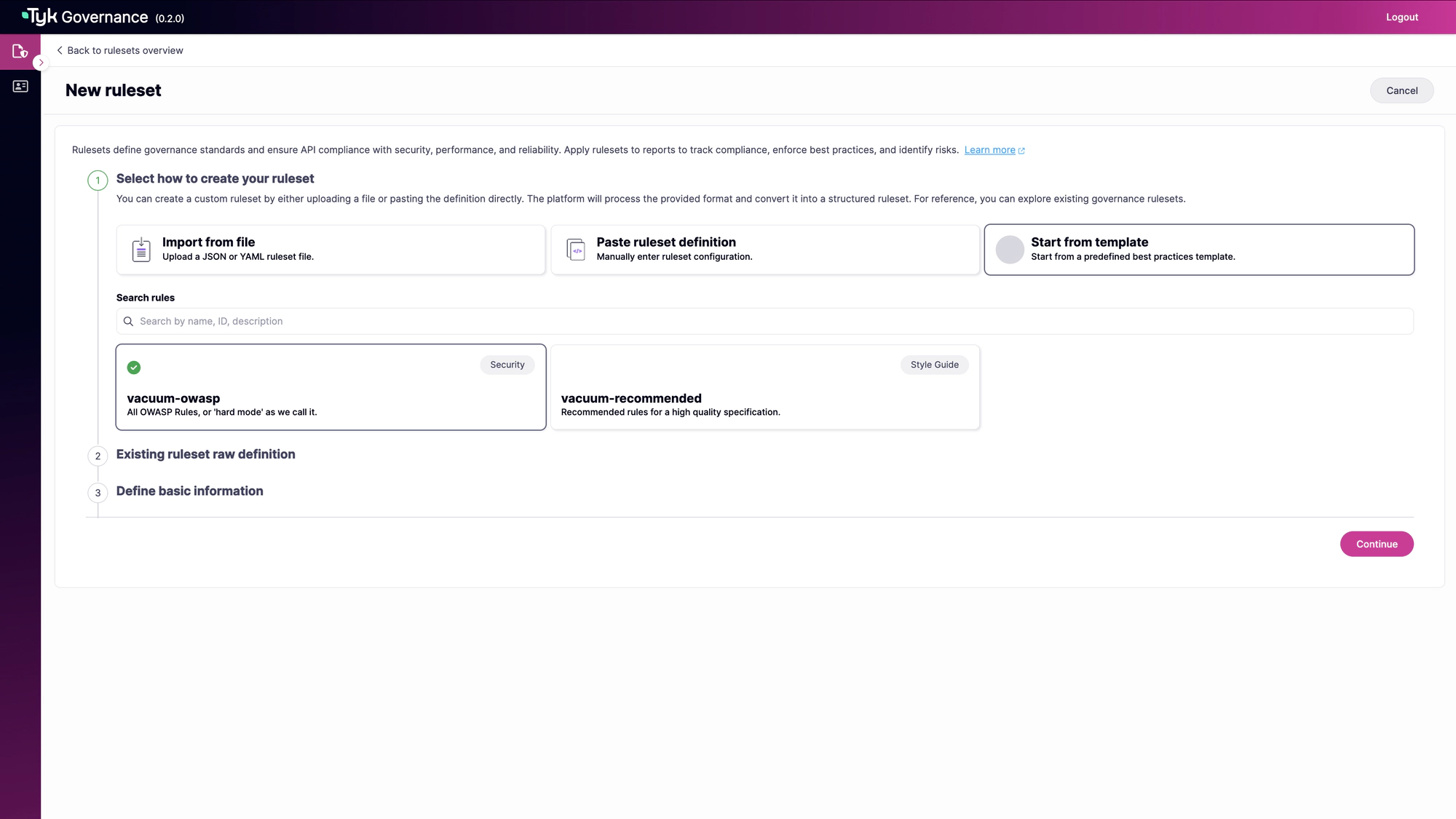
-
Customize Your Ruleset
Review the pre-configured rules. You can enable/disable specific rules or adjust their severity levels.
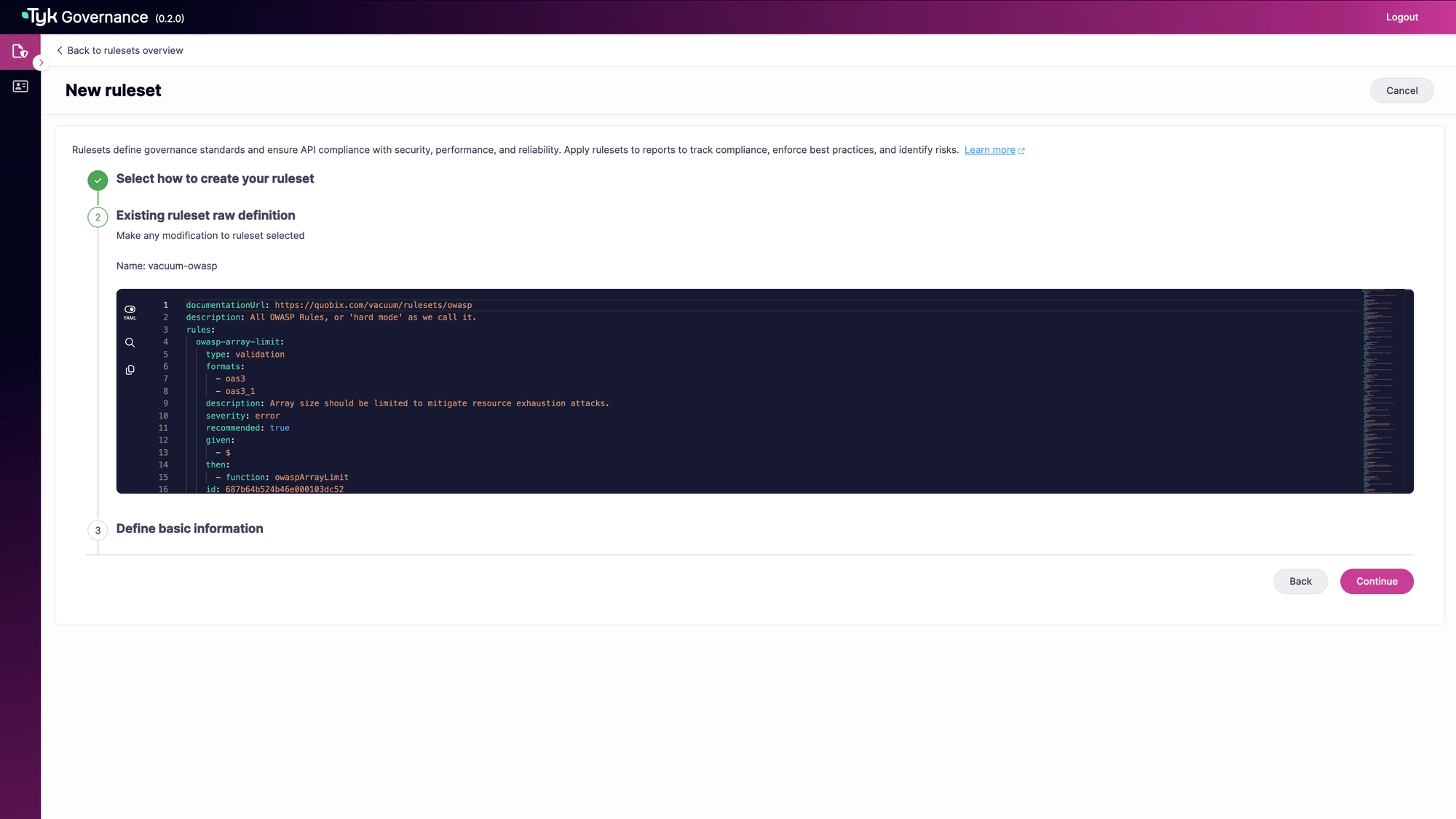
Then, provide a name and description for your ruleset.
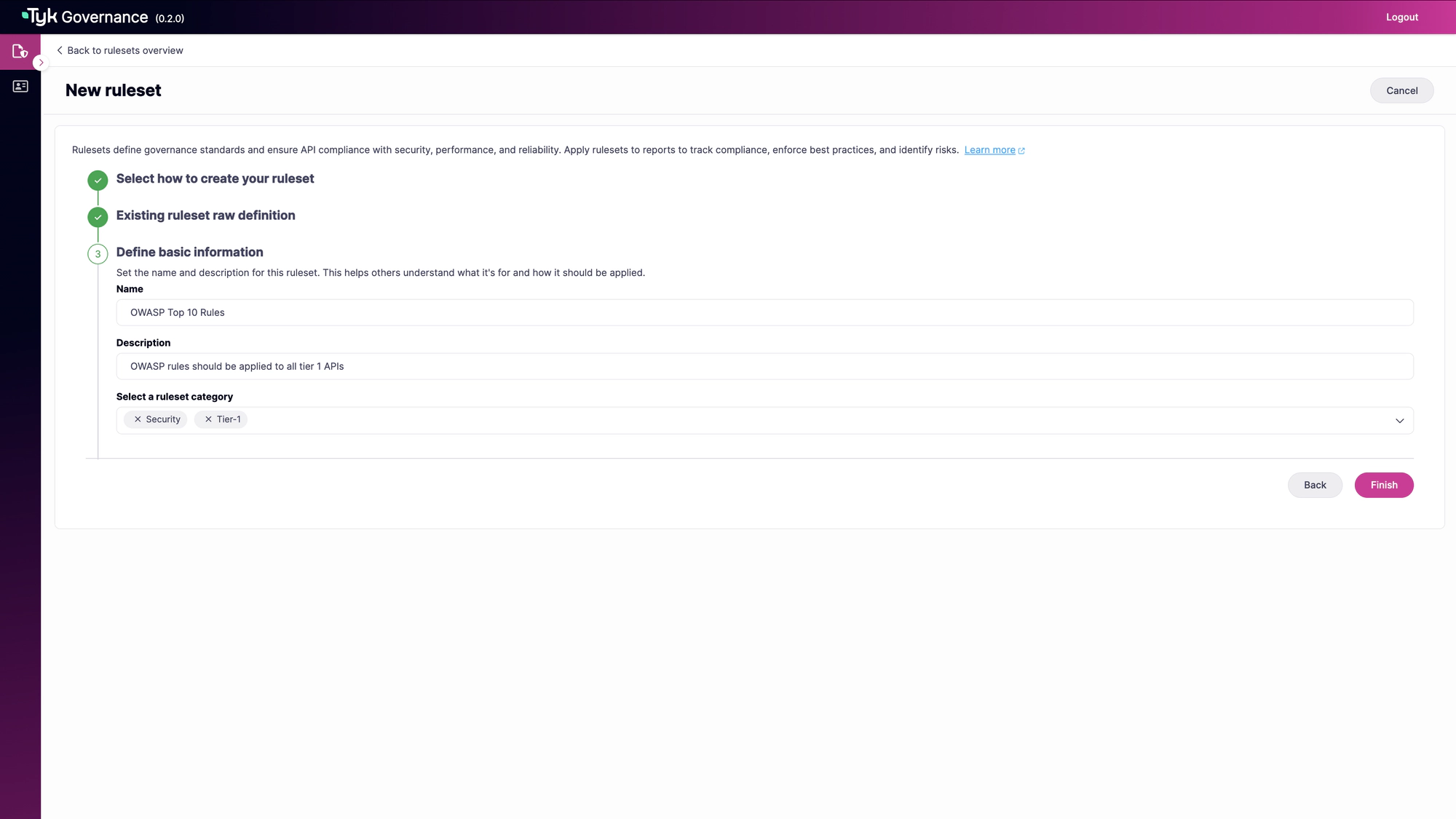
-
Save Your Ruleset
Click Finish to create your new ruleset.
-
View Your Ruleset
Your new ruleset will appear in the rulesets list. Click on it to view details and manage individual rules.
Validation
- Successful ruleset creation will be confirmed with a success message
- The ruleset will appear in your rulesets list
- You can now use this ruleset to evaluate APIs
How It Works
Governance Rulesets use a powerful rule engine based on the Spectral format to define standards for API specifications. Each rule consists of a selector that identifies parts of the API specification to evaluate, a function that performs the evaluation, and metadata that provides context and remediation guidance.
Rule Structure
A typical rule in a ruleset includes:
- Given: A JSONPath expression that selects parts of the API specification
- Then: Functions to apply to the selected parts
- Severity: The importance level (error, warn, info, hint)
- Message: A description of what the rule checks
- HowToFix: Guidance on resolving any violations
When you create a ruleset, you’re defining a collection of these rules that work together to enforce your governance standards.
Example Rulesets
Security Standards Ruleset
Create rulesets that define security requirements for APIs, such as authentication requirements, secure endpoints, and protection against common vulnerabilities.
security-auth-required:
description: APIs must require authentication
severity: error
given: $.paths.*.*
then:
field: security
function: truthy
howToFix: "Add a security requirement to this operation"
API Design Standards Ruleset
Define rules that enforce naming conventions, URL patterns, and response structures to maintain consistency across your API portfolio.
path-case-convention:
description: Path segments must use kebab-case
severity: warn
given: $.paths
then:
field: "@key"
function: pattern
functionOptions:
match: "^\/([a-z0-9-]+|{[a-zA-Z0-9_]+})(\/{[a-zA-Z0-9_]+}|\/[a-z0-9-]+)*$"
howToFix: "Rename path segments to use kebab-case (lowercase with hyphens)"
Documentation Standards Ruleset
Create rules that check for complete and accurate documentation, including descriptions, examples, and response schemas.
operation-description:
description: All operations must have descriptions
severity: warn
given: $.paths.*.*
then:
field: description
function: truthy
howToFix: "Add a meaningful description to this operation"
Manage Rulesets
Creating Rulesets
Rulesets define governance standards and ensure API compliance with security, performance, and reliability requirements. You can create rulesets through the Governance UI or programmatically via the API.
Using the UI
The Governance UI provides a user-friendly interface for creating rulesets:
- Navigate to the Rulesets section
- Click Create new ruleset
- Choose how to create your ruleset (import from file, paste definition, or start from template)
- Provide basic information (name, description)
- Save your ruleset
Using the API
You can also create rulesets programmatically using the API.
Creating a Ruleset with JSON Payload
curl -X POST https://your-governance-instance.tyk.io/api/rulesets \
-H "Content-Type: application/json" \
-H "X-API-Key: YOUR_API_KEY" \
-d '{
"metadata": {
"name": "Security Standards",
"description": "Security rules for all APIs",
"active": true
},
"ruleset": {
"rules": {
"security-auth-required": {
"description": "APIs must require authentication",
"severity": "error",
"given": "$.paths.*.*",
"then": {
"field": "security",
"function": "truthy"
},
"howToFix": "Add a security requirement to this operation"
}
}
}
}'
Creating Rulesets from Files
For more complex rulesets or when you maintain your rulesets as files in your development environment, you can create rulesets directly from files using a multipart form request.
To create a ruleset from a file, you need to send a multipart form request with two key components:
metadata: JSON object containing ruleset metadata (name, description, etc.)ruleset: The ruleset definition file content (in YAML or JSON format)
Here’s how to create a ruleset from a YAML file using curl:
curl -X POST https://your-governance-instance.tyk.io/api/rulesets \
-H "X-API-Key: YOUR_API_KEY" \
-F "metadata={\"name\":\"API Security Ruleset\",\"description\":\"Enforces API security best practices\",\"active\":true}" \
-F "ruleset=@/path/to/your/ruleset.yaml"
Managing Rulesets
Once created, rulesets can be managed through the UI or API:
Viewing Rulesets
- Navigate to the Rulesets section to see all rulesets
- Click on a ruleset to view its details and rules
- Use search to find specific rulesets
Editing Rulesets
- From the ruleset details page, click Configure ruleset
- Modify ruleset metadata or individual rules
- Save your changes
Using Templates
- When creating a new ruleset, select Start from Template
- Choose from pre-built templates for common standards
- Customize the template to meet your specific needs
Testing Rulesets Against APIs
After creating your ruleset, you’ll want to test it against your APIs to ensure it correctly identifies compliance issues. You can test a ruleset through the Governance UI:
-
Navigate to the Ruleset Details Page
- Go to the Rulesets section and select the ruleset you want to test
-
Run an Evaluation
-
In the ruleset details page, locate the “Test ruleset” section
-
Select an API from the dropdown menu
-
Click the “Run ruleset” button
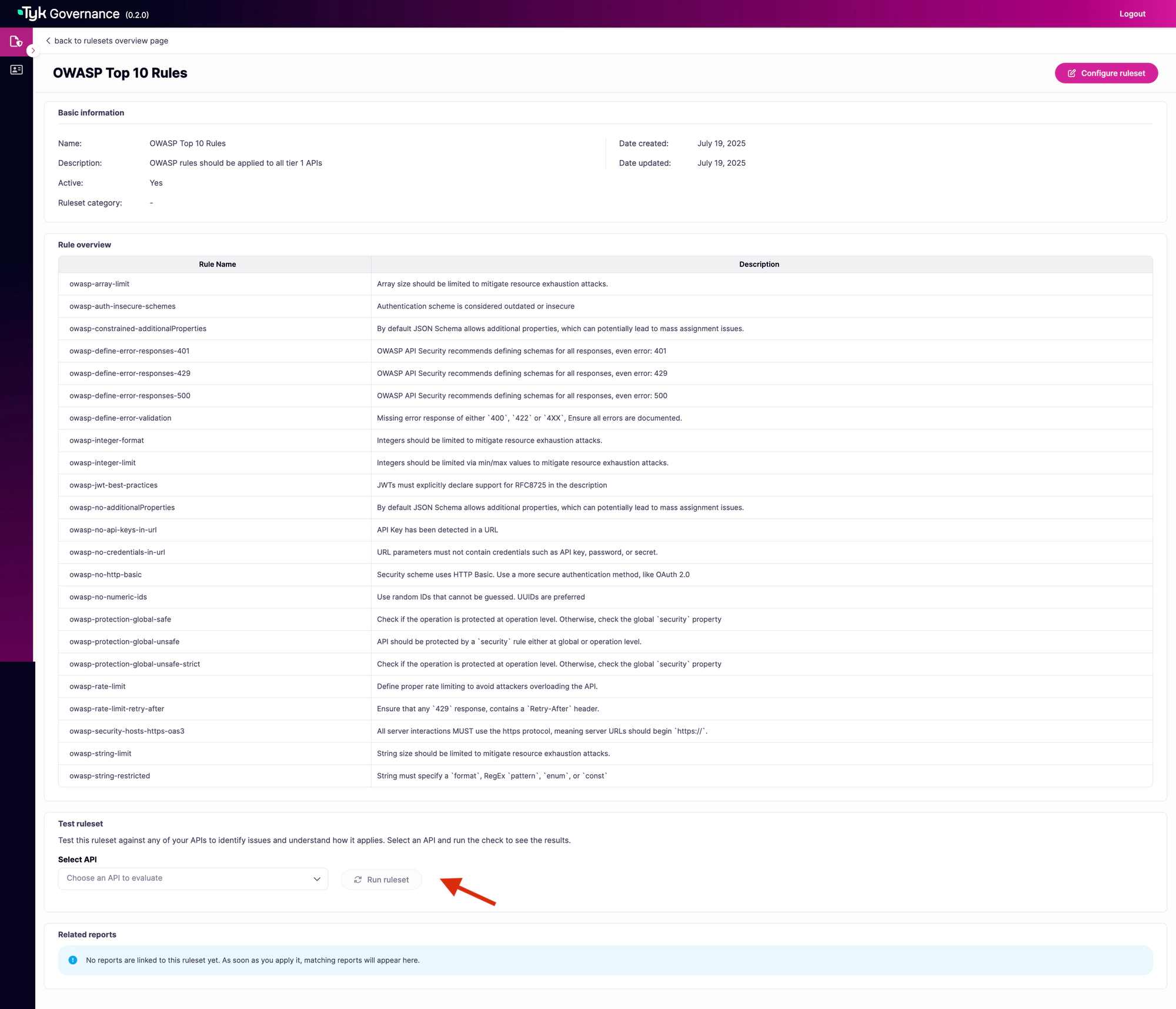
-
-
Review Results
- The evaluation results will display any rule violations found in the API
- Results are categorized by severity (High, Medium, Low)
- Click “View issue info” on any violation to see detailed information including:
- The specific rule that was violated
- The affected area in the API specification
- Guidance on how to fix the issue
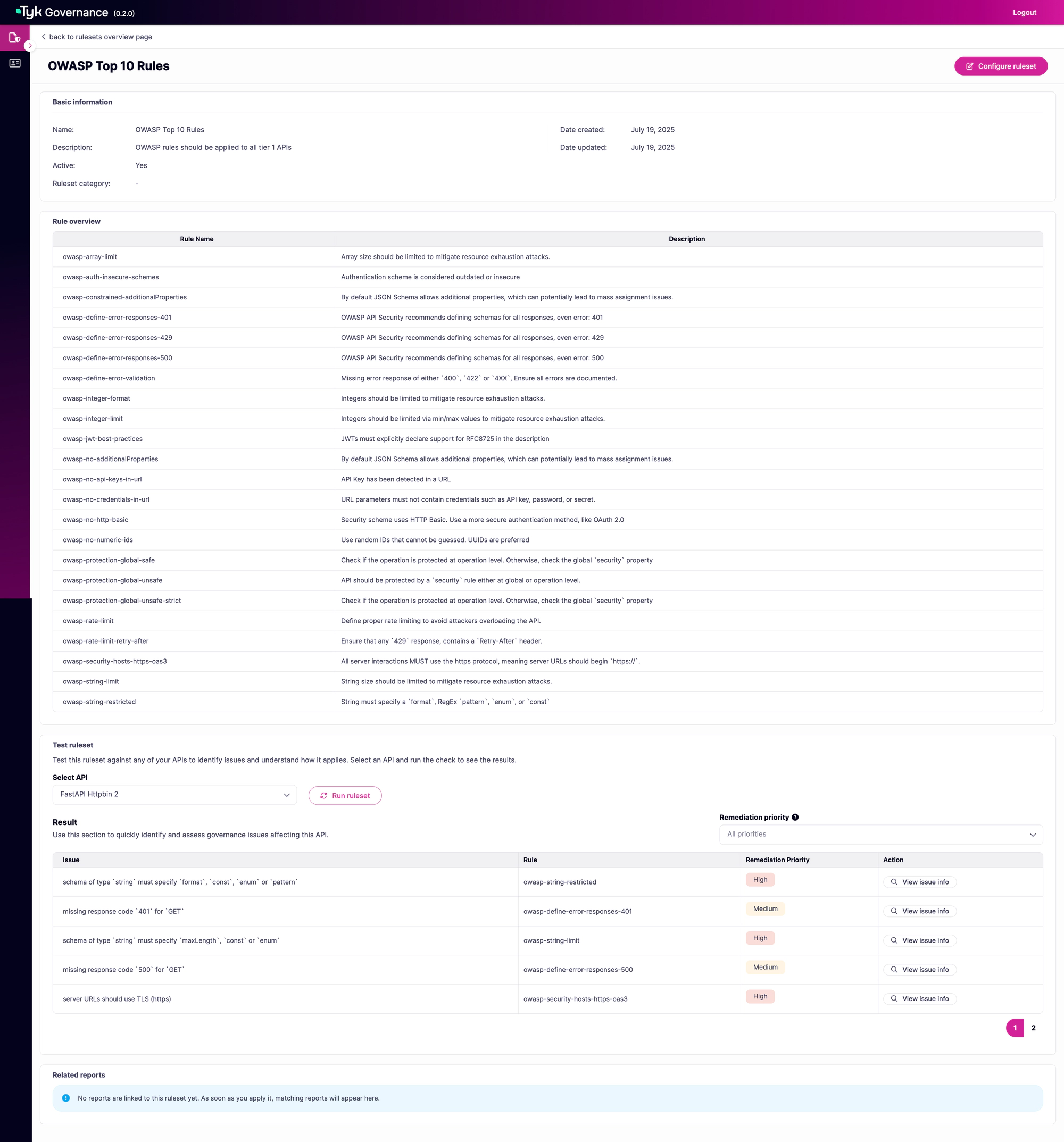
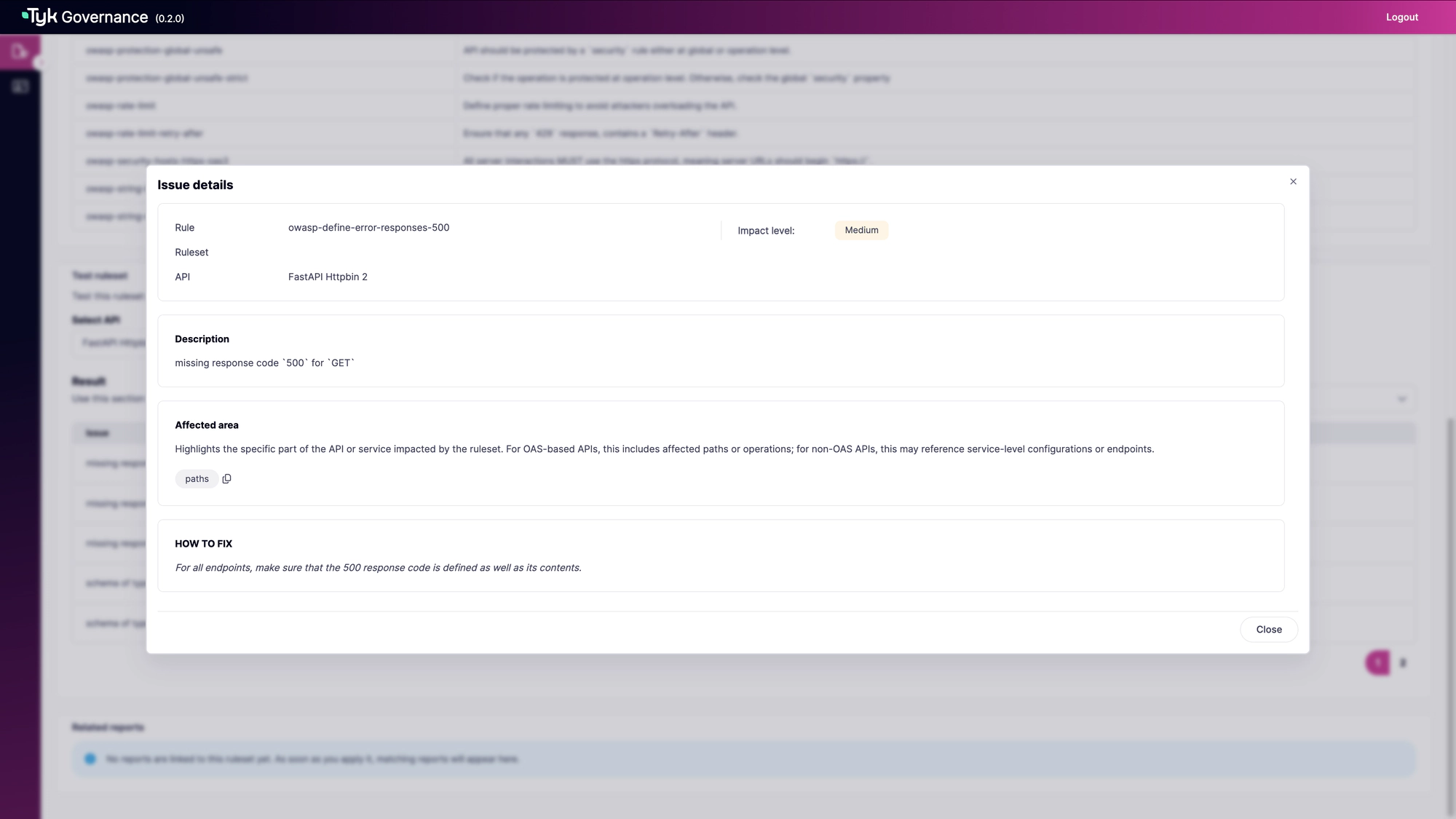
Understanding Remediation Priority
In Tyk Governance, “Remediation Priority” indicates how urgently an API issue should be addressed based on its risk level and potential impact. This priority helps teams focus their efforts on the most critical issues first.
Severity Mapping
Remediation priority is directly derived from the severity level defined in the rule. When a rule violation is detected during evaluation, its severity level is mapped to a corresponding remediation priority:
| Severity Level | Remediation Priority | Visual Indicator |
|---|---|---|
| error | High | Red pill |
| warn | Medium | Yellow/orange pill |
| info | Low | Green pill |
Use Cases
Establishing Tiered Governance Standards
Create different rulesets for different API tiers based on criticality, allowing for appropriate governance without over-restricting less critical APIs.
Implementation:
- Create a “Tier 1” ruleset with strict security, design, and documentation rules for mission-critical APIs
- Create a “Tier 2” ruleset with moderate requirements for important but less critical APIs
- Create a “Tier 3” ruleset with basic requirements for internal or non-critical APIs
- Apply these rulesets selectively based on API classification
Benefits:
- Appropriate governance based on API importance
- More efficient use of development resources
- Clear expectations for different types of APIs
Implementing Industry-Specific Standards
Create rulesets that enforce industry-specific regulations and best practices for APIs in regulated sectors.
Implementation:
- Identify relevant industry standards (e.g., FAPI for financial services, HIPAA for healthcare)
- Create rulesets that codify these standards as executable rules
- Include detailed remediation guidance specific to the industry context
- Apply these rulesets to APIs in the relevant domains
Benefits:
- Ensure compliance with industry regulations
- Reduce audit preparation time
- Standardize compliance approaches across teams
Evolving Governance Standards Over Time
Use rulesets to gradually implement and evolve governance standards as your organization’s API program matures.
Implementation:
- Start with a basic ruleset focusing on critical security and fundamental design principles
- Gradually add more rules as teams become familiar with the standards
- Adjust severity levels over time (e.g., start as warns, later promote to errors)
- Incorporate feedback from development teams to refine rules
Benefits:
- Avoid overwhelming teams with too many rules at once
- Build governance maturity incrementally
- Gain buy-in through collaborative evolution
Best Practices and Recommendations
- Start with templates for common standards like OWASP or OpenAPI best practices
- Customize gradually by adding organization-specific rules over time
- Use appropriate severity levels - reserve “error” for critical issues that must be fixed
- Include clear remediation guidance in the “howToFix” field for each rule
- Group related rules into focused rulesets (security, design, documentation)
- Review and update rulesets regularly as standards evolve
- Collect feedback from developers on rule clarity and usefulness
- Document the purpose of each ruleset for better organizational understanding
- Maintain version control for rulesets as they evolve
- Assign ownership to specific individuals or teams for each ruleset
FAQs
What rule formats are supported?
Tyk Governance supports Spectral-compatible rulesets in both YAML and JSON formats. This makes it compatible with existing Spectral rulesets and allows for easy migration from other tools.
Can I create custom functions for rules?
Currently, Tyk Governance supports the standard functions provided by the Spectral/Vacuum engine. Custom functions are planned for future releases.
How many rules can I have in a ruleset?
There’s no hard limit on the number of rules in a ruleset, but performance may degrade with very large rulesets (100+ rules). We recommend organizing related rules into separate rulesets for better manageability and performance.
Can I import existing Spectral rulesets?
Yes, you can import existing Spectral rulesets in YAML or JSON format. This allows you to leverage your existing governance rules in Tyk Governance.
How do I use these rulesets to validate APIs?
Once you’ve created rulesets, you can use them to validate APIs through the API Evaluation feature, which allows you to check API specifications against your governance standards.
Troubleshooting
Error when creating or importing a ruleset
- Verify the ruleset is in valid YAML or JSON format
- Check that all required fields are present (given, then, severity)
- Ensure JSONPath expressions are valid
- Look for syntax errors in function options
- Try importing a smaller portion of the ruleset to identify problematic rules
Rule not appearing in ruleset
- Check that the rule definition follows the correct format
- Verify that the rule wasn’t disabled during import
- Ensure the rule has a unique name within the ruleset
- Try adding the rule manually if it was part of an import
JSONPath expression not working as expected
- Test your JSONPath expression with a sample API specification
- Verify the syntax follows JSONPath standards
- Check for typos or missing elements in the path
- Consider simplifying complex expressions
- Use online JSONPath evaluators to debug expressions
Changes to ruleset not saving
- Ensure you have the necessary permissions
- Check for validation errors in the ruleset definition
- Verify you’re clicking the final save button after making changes
- Try refreshing the page and making changes again
- Check browser console for any JavaScript errors